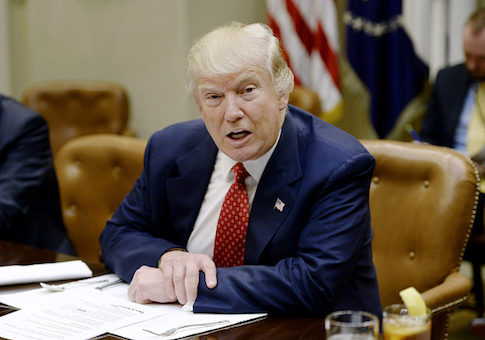Donald Trump's budget calls for a 21 percent cut to the Department of Labor in order to free up tax dollars for military spending.
The budget blueprint released by the White House on Thursday indicated that the administration intends to scale back the agency's operations and refocus enforcement efforts. The blueprint acknowledges that the department is key to "safeguarding their working conditions, benefits, and wages," but says that cuts are necessary to offset increases to defense spending.
"With the need to rebuild the Nation’s military without increasing the deficit, this Budget focuses the Department of Labor on its highest priority functions and disinvests in activities that are duplicative, unnecessary, unproven, or ineffective," the brief section on labor says.
The proposed budget would allocate $9.6 billion to the department, a $2.5 billion decrease from the $13.1 billion level called for in the 2017 continuing resolution. The department will shoulder about 4.6 percent of the total reductions that Trump is seeking in order to raise military spending by $54 billion.
"These cuts are sensible and rational. Every agency and department will be driven to achieve greater efficiency and to eliminate wasteful spending in carrying out their honorable service to the American people," Trump said in a letter attached to the blueprint.
Labor unions criticized the steep cuts, saying that they would reduce job training programs, as well as safety enforcement training. The AFL-CIO, the nation's largest union with 13 million members, called the cuts to the department and other services "dangerous and destructive."
"Huge cuts to the departments of Labor, Education and Transportation will make workplaces less safe, put more children at risk and make improving our failing infrastructure much more difficult," AFL-CIO president Richard Trumka said in a statement. "The administration can and should do better."
A department spokeswoman pushed back on the notion that the cuts would hinder worker protections. The administration claims that the training program cuts only target ineffective agency efforts. An agency fact sheet singled out the $434 million Senior Community Service Employment Program, which it said failed to help older workers find jobs. "One-third of participants fail to complete the program and of those who do, only half successfully transition to unsubsidized employment," the sheet says. A leaner budget would force the department to concentrate its spending on its core functions and give state and local leaders a larger role in spending allocations for apprenticeships and job creation, according to the spokeswoman.
"President Trump’s proposed budget ensures the Department of Labor focuses its resources on protecting workers and advancing opportunity," spokeswoman Jillian Rogers said in a statement.
A senior White House adviser, who requested anonymity to speak candidly about Trump's labor agenda, said that the administration plans on rolling back intrusive regulation enforcement implemented by President Obama.
He pointed to the Department of Labor's overtime regulations, which would double the threshold at which white collar workers must be paid overtime, as an example of the previous administration's overreach. Doubling the threshold would lead to more enforcement and broader investigations, which would expand the agency's role in the workplace and its budget. That rule is in legal jeopardy after a federal judge appointed by Obama blocked its implementation in November. The adviser said that cutting back on red tape would make it easier to increase economic output and create more jobs.
"It's very clear that the Obama administration went way overboard with his regulatory push," the adviser said. "We don’t want it to be hard to do business in America … [Trump's] agenda in terms of deregulation is not deregulation for deregulation's sake."
Congress has not properly agreed on a budget for two decades. The federal government has relied on continuing resolutions and omnibus spending packages to finance spending every year since 1996.
